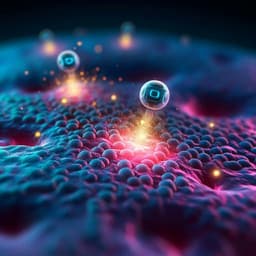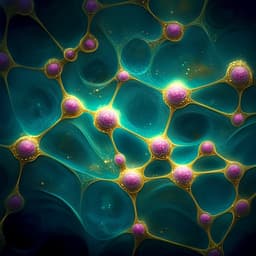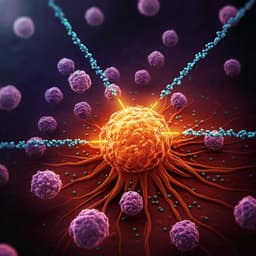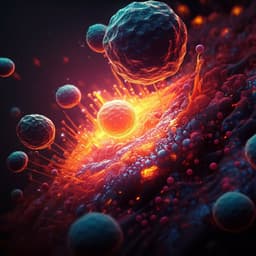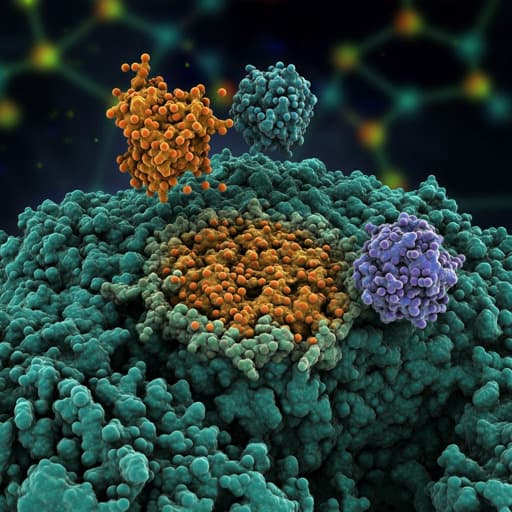
Biology
Tailored Functionalized Protein Nanocarriers for Cancer Therapy: Recent Developments and Prospects
R. J. Babu, A. K. Tiwari, et al.
Discover groundbreaking advancements in protein nanoparticle technology for cancer therapy, exploring tailored construction methods and innovative therapeutic applications. This insightful review, conducted by an expert team, reveals the tumor-targeting capabilities of engineered protein-based nanoparticles and their potential to overcome multidrug resistance.
~3 min • Beginner • English
Introduction
The study addresses the need for effective, targeted delivery systems for cancer therapeutics due to rising cancer mortality and the limitations of conventional antitumor drugs that lack tissue selectivity. Nanotechnology-based delivery platforms can enhance site-specific targeting, bioavailability, biodistribution, protect drugs from degradation, prolong circulation, and reduce off-target toxicity. Among nanoscale systems (metallic nanoparticles, liposomes, protein nanoparticles), protein-based carriers are highlighted for their tunable particle size, surface properties, and controlled release profiles. The review focuses on natural and de novo designed protein nanoparticles, emphasizing how genetic engineering offers precise control over stereochemistry, structure, self-assembly, surface charge, environmental responsiveness, cargo loading, stability, and ligand display beyond what natural or synthetic non-protein systems can typically achieve. The purpose is to summarize the state of engineered protein nanocages (e.g., ferritins, vaults, encapsulins, small heat shock proteins, elastin-like polypeptides), their functionalization strategies, pharmacological properties, and applications in cancer therapy, including overcoming delivery barriers and multidrug resistance.
Literature Review
The review synthesizes advances across classes of protein nanocarriers:
- Ferritins (Fn): Recombinant human ferritin nanocages functionalized genetically or chemically for targeted chemotherapy (e.g., TFR1-targeting for glioma, pH-triggered loading/release, high hydrostatic pressure loading, biosilica coating for single/dual drug delivery, targeting TAMs with M2pep, luciferin conjugation for tracking, antibody-guided cisplatin delivery).
- Vaults: Large ribonucleoprotein nanoparticles (MVP-based) engineered for endosomal escape (pVI fusions), receptor targeting, chemokine (CCL21) delivery to inhibit lung cancer growth, and conjugation of antiretroviral drugs; improvements in production/purification (human cell expression, IMAC) and stability (biosilicification).
- Encapsulins: Bacterial/archaeal protein nanocages genetically modified for targeting (SP94, Fc-binding peptide), chemotherapeutic loading (Aldoxorubicin), theranostics (miniSOG, DARPin9.29), modular Load-and-Display platforms using SpyTag/SpyCatcher and split inteins, and vaccine applications with simultaneous cargo loading and antigen display.
- Small Heat Shock Proteins (sHSPs): Mj-sHSP cages with pH-sensitive DOX linkers and tumor-targeting peptides (RGD-4C, SP94), and TAT-fused, PEG/PAHA-coated constructs for tumor microenvironment-triggered delivery and release.
- Elastin-like Polypeptides (ELPs): Thermoresponsive, genetically encoded polymers forming micelles/coacervates, engineered for targeted delivery (iRGD, GE11), overcoming MDR via CPP/MMP-cleavable DOX conjugates, antibody-ELP multivalent nanoparticles (αPD-1, anti-CD99 nanoworms), photodynamic nanomedicine with VHH fusions, and biomineralization (silica) for stability and controlled release.
- De novo designs: Computationally designed symmetric nanocages (Rosetta-based), SAGE peptide cages functionalized with proteins/antigens, programmable dendrimer-like protein assemblies via orthogonal tag/catcher systems (Spy/Snoop, SnoopLigase), coiled-coil protein origami cages, and histidine/cation-driven oligomerization platforms for targeted nanoconjugates (e.g., GFP-based CXCR4-targeted carriers delivering Ara-C or MMAE).
Collectively, the literature indicates protein nanocarriers’ versatility in precise targeting, controlled release, multifunctionality, and potential for rational vaccine/drug design.
Methodology
This is a narrative review. The authors compile and synthesize data from recent publications on natural and de novo designed protein nanoparticles for cancer therapy. They summarize genetic and chemical functionalization strategies, production methods, loading approaches, physicochemical properties, and in vitro/in vivo outcomes reported across studies, rather than conducting new experiments.
Key Findings
- Ferritin nanocages:
• HFn–paclitaxel (PTX) targeted TFR1+ glioma cells, extending median survival to 30 days vs. saline (13) and free PTX (14) in mice.
• One-step pH 9 incubation method increased DOX loading capacity (~3×) and encapsulation efficiency (~10×) vs. traditional disassembly/assembly (3–4% loading).
• High hydrostatic pressure (500 MPa, pH 5.5) with 20 mM arginine prevented aggregation and achieved 100% protein recovery for DOX/Fn.
• M2pep-functionalized Fn delivering CpG ODNs repolarized TAMs (M2→M1) and inhibited tumor growth.
• Biosilica-enveloped Fn enabled pH-responsive release and dual-drug delivery (SiO2(PTX)/Fn(DOX)) with temporally separated release (PTX short-term, DOX long-term).
- Vault nanoparticles:
• pVI-MVP fusions enhanced endosomal escape and targeted delivery to EGFR+ cells.
• CCL21-loaded vaults increased leukocyte infiltration and reduced lung tumor growth in mice.
• Human vaults conjugated with antiretrovirals achieved targeted delivery to key HIV-1 target cells.
• Streamlined production: His-tagged MVP expressed in human cells allowed one-step IMAC purification with co-loaded INT-tagged cargo.
• Biosilicification improved vault stability for biosensor/drug delivery applications.
- Encapsulins:
• SP94-displayed encapsulins selectively targeted HepG2; AlDOX loading retained cytotoxicity without intrinsic carrier toxicity.
• FcBP-encapsulins specifically bound SCC-7 cells for imaging.
• DARPin9.29/miniSOG-encapsulins targeted HER2+ breast cancer cells and induced apoptosis; modular Load-and-Display enabled exterior ligand display and interior cargo encapsulation (e.g., Nluc, EGFP) with functional applications (targeted imaging, enzyme stabilization).
• Encapsulins used as vaccine platforms with simultaneous antigen display and cargo loading elicited antibody responses in mice.
- Small Heat Shock Proteins:
• Mj-sHSP inner cysteines with pH-sensitive DOX linkers enabled selective drug release in acidic environments; external RGD-4C or SP94 conferred cell-specific targeting, reducing toxicity to normal hepatocytes while maintaining HCC cytotoxicity.
• TAT-fused, PEG/PAHA-coated sHSP nanoparticles showed tumor-targeted accumulation and pH/HAase-triggered PTX release in the tumor microenvironment.
- Elastin-like Polypeptides:
• Silaffin-R5-tagged ELP-DOX micelles biomineralized with silica exhibited uniform hybrids with pH-dependent DOX release.
• iRGD-ELP-D nanoparticles delivered PTX via integrin/NRP-1 targeting with enhanced internalization and cytotoxicity to cancer cells.
• GE11-coated ELPs delivering PCK3145 increased apoptosis (~2×) and inhibited tumor growth in colon cancer models.
• ELP-CPP-MMP-cleavable DOX constructs increased penetration (~4×) and doubled killing of resistant cells, overcoming MDR; ELP conjugation improved pharmacokinetics and efficacy vs. free DOX.
• VHH-ELP assemblies retained EGFR binding and enabled photodynamic killing upon photosensitizer incorporation.
• αPD-1 scFv-ELP nanoparticles showed higher binding affinity than intact antibody; anti-CD99 scFv-ELP nanoworms extended circulation (t1/2 ~16 h, retention ~21.3 h) and reduced leukemia burden, improving survival in mice.
- De novo protein assemblies:
• Rosetta-designed symmetric nanocages (24 subunits) matched computational models and provide programmable scaffolds for vaccines/drugs.
• SAGE peptide cages (~100 nm) functionalized with proteins/antigens modulated cellular uptake and enhanced antigen-specific T cell/antibody responses depending on fusion orientation.
• Orthogonal Tag/Catcher systems (Spy/Snoop; SnoopLigase) enabled stepwise growth of protein dendrimers with increased multivalent binding and cytotoxic cargo delivery; multivalent antigen display boosted antibody responses (~100-fold) after single immunization.
• Coiled-coil protein origami cages assembled in vitro/in vivo without inflammation, suggesting suitability for medical delivery.
• Histidine-rich, divalent cation–mediated oligomerization produced stable GFP-based targeted nanoparticles (e.g., T22-GFP-H6) with sustained circulation, allowing multivalent drug (Ara-C pentamer, MMAE) delivery and efficacy against AML in mice.
Discussion
Tailored functionalized protein nanocarriers address key challenges in cancer therapy by enabling precise targeting, controlled and stimuli-responsive release, and modular incorporation of therapeutic and diagnostic functions. Natural protein cages (ferritin, vaults, encapsulins, sHSPs, ELPs) offer inherent biocompatibility and biodegradability, while genetic and chemical engineering adds tunable properties such as receptor targeting (e.g., TFR1, EGFR, HER2, CXCR4), immune modulation (e.g., TAM repolarization), endosomal escape, and improved loading strategies (pH-triggered, high-pressure, biomineralization). These strategies demonstrated meaningful in vivo outcomes, including extended survival, tumor growth inhibition, decreased off-target toxicity, and overcoming multidrug resistance. De novo computationally designed assemblies expand the design space beyond natural architectures, enabling homogeneous, predictable nanostructures with programmable valency and orientation for strong multivalent interactions, efficient antigen presentation, and controlled cargo organization. Together, the findings substantiate the premise that protein-based, engineered nanocarriers can improve therapeutic index and pave the way for rational vaccine and drug design, with translational potential contingent on scalable production and stability.
Conclusion
This review consolidates recent advances in engineered protein nanocarriers for cancer therapy, highlighting natural protein cages (ferritin, vaults, encapsulins, sHSPs, ELPs) and de novo designed assemblies as versatile platforms for targeted, controlled, and multifunctional delivery. Key contributions include improved drug loading and stability (e.g., pH-triggered loading, high-pressure encapsulation, biomineralization), receptor-specific targeting and immune modulation, MDR circumvention, and integration of theranostic capabilities. Computational approaches now enable highly homogeneous, programmable nanostructures for vaccines and therapeutics. Future research should address immunogenicity mitigation, robustness and long-term stability, standardized and scalable bioproduction, and comprehensive in vivo validation including pharmacokinetics, biodistribution, and safety. Advances in molecular dynamics, synthetic biology, and genome editing will be instrumental in translating tailored protein nanocarriers to clinical applications.
Limitations
As a narrative review, the work does not present new experimental data or a systematic/meta-analytic assessment. Reported successes are drawn from heterogeneous studies with varying models and endpoints, limiting direct comparability. Key translational challenges remain: potential immunogenicity leading to rapid clearance or neutralization; protein aggregation during loading; manufacturing complexity, batch-to-batch consistency, and scale-up; long-term stability and storage; and navigating in vivo barriers and variability of tumor microenvironments. Further standardized preclinical and clinical studies are required to establish safety, efficacy, and manufacturability.
Related Publications
Explore these studies to deepen your understanding of the subject.



